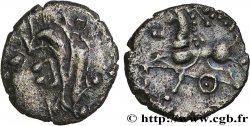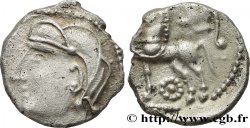bga_530299 - GALLIA - LEMOVICES (Regione di Limoges) Statère à la grue, en argent / billon
non disponibile.
Articolo venduto sul nostro negozio (2021)
Prezzo : 1 125.00 €
Articolo venduto sul nostro negozio (2021)
Prezzo : 1 125.00 €
Tipo : Statère à la grue, en argent / billon
Data: c. 100-50 BC.
Nome della officina / città: Limoges (87)
Metallo : argento
Diametro : 16,5 mm
Asse di coniazione : 12 h.
Peso : 4,91 g.
Grado di rarità : INÉDIT
Commenti sullo stato di conservazione:
Très bel exemplaire avec un joli revers complet et bien centré. Manque de métal au droit à 12h. Patine de collection ancienne
N° nelle opere di riferimento :
Diritto
Titolatura diritto : ANÉPIGRAPHE.
Descrittivo diritto : Tête à droite, la chevelure en grosses mèches aquitaniques, l’oreille marquée.
Rovescio
Titolatura rovescio : ANÉPIGRAPHE.
Descrittivo rovescio : Cheval à droite, une grue posée sur la croupe entre deux annelets pointés ; un trèfle entre les jambes.
Commento
Avec un flan de 5 mm d’épaisseur et un métal très fortement chargé en argent, cette monnaie se distingue des frappes en or et en bronze ; si le style de flan correspond aux monnaies en bronze, cet exemplaire en billon ou en argent semble être sans équivalent et manquer aux ouvrages de références !
Le motif d‘accolade partant de la bouche (hors flan sur cet exemplaire) devant le visage, est parfois interprété comme le signe de la parole ; on retrouve ce détail sur les statères des Bituriges, mais aussi sous forme des deux dauphins, plus ou moins stylisés, sur la plupart des monnaies d’argent du sud, dites “à la croix”.
With a 5 mm thick flan and a metal heavily loaded with silver, this coin stands out from the gold and bronze strikes; if the flan style corresponds to the bronze coins, this example in billon or silver seems to be without equivalent and missing from reference works! The brace motif starting from the mouth (off flan on this example) in front of the face, is sometimes interpreted as the sign of speech; we find this detail on the staters of the Bituriges, but also in the form of the two dolphins, more or less stylized, on most of the silver coins of the south, called “with the cross”
Le motif d‘accolade partant de la bouche (hors flan sur cet exemplaire) devant le visage, est parfois interprété comme le signe de la parole ; on retrouve ce détail sur les statères des Bituriges, mais aussi sous forme des deux dauphins, plus ou moins stylisés, sur la plupart des monnaies d’argent du sud, dites “à la croix”.
With a 5 mm thick flan and a metal heavily loaded with silver, this coin stands out from the gold and bronze strikes; if the flan style corresponds to the bronze coins, this example in billon or silver seems to be without equivalent and missing from reference works! The brace motif starting from the mouth (off flan on this example) in front of the face, is sometimes interpreted as the sign of speech; we find this detail on the staters of the Bituriges, but also in the form of the two dolphins, more or less stylized, on most of the silver coins of the south, called “with the cross”








 Segnalare un errore
Segnalare un errore Stampate la pagina
Stampate la pagina Condividi mia selezione
Condividi mia selezione Fai una domanda
Fai una domanda Consegnare / vendere
Consegnare / vendere
 Descrittivo
Descrittivo









